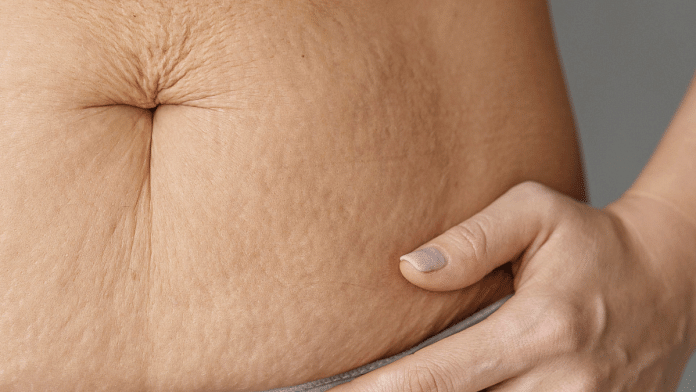Stretch marks or striae are common benign skin lesions that can impact one’s self-confidence, especially if they appear on exposed body parts. It is common among both men and women and can be stressful for many patients. Rapid weight gain or loss, long-term obesity, muscle hypertrophy, which is often experienced by bodybuilders, endocrinopathies like Cushing syndrome, and breast augmentation can result in stretch marks. Moreover, 50 to 90 per cent of pregnant women develop them during their third trimester. Stretch marks can also be a side effect of the use and abuse of topical corticosteroids, which are widely available ointments that reduce inflammation and irritation. Gymgoers who use tissue expanders, too, complain of stretch marks.
These indented streaks are a sign of stressed skin — a result of sudden tightening or loosening of the skin due to various physiological-biochemical changes in the body. There are different types of stretch marks: striae atrophicans (thinned skin), striae gravidarum (marks following pregnancy), striae distensae (stretched skin), striae rubrae (red streaks), striae albae (white streaks), striae nigra (black streaks), and striae caerulea (dark blue).
Striae rubrae manifest in pink, purple, or red lines on the skin, accompanied by an itching sensation. These stretch marks are the most receptive to therapy and can be treated if you reach out to your doctor at the right stage. Purple or red streaks can turn white or silver over time, resulting in striae albae, which are less visible on the body but more difficult to treat.
What you can do
Stretch marks vary from one person to another, depending on their causes and other factors such as genetics, skin type, and skincare regimes.
To avoid the development of stretch marks and improve skin elasticity, it is important to maintain a healthy weight, stay hydrated, and moisturise your skin regularly. Use creams containing jojoba oil, coconut oil, almond oil, cocoa or shea butter. If you live in a place with a humid climate, try moisturisers that are suitable for your skin type. Take a bath with glycerin-rich soaps, which hydrate your skin better than other bathing bars. Consistent and proactive skincare practices are key.
Muscle-building exercises can be beneficial too. Any medications you might be taking regularly can contribute to the development of stretch marks. Consult a healthcare professional or dermatologist for specific concerns before using any topical treatments or over-the-counter creams or oils to treat stretch marks and prevent them from becoming permanent scars.
Also read: Your hair loss is not solely about genes. Air pollution is turning you bald…
Pregnant women, take note
Pregnant women should take proactive steps early on. Consult your doctor about light exercises to gradually gain weight. Stretch marks that turn white at the time of delivery are stubborn to treat or can even be untreatable. Some simple tips to avoid stretch marks include drinking enough water, applying jojoba oil, coconut oil, or Vitamin E ointments on the body regularly, and consuming a balanced diet. Consume more fruits, vegetables, and foods rich in omega-3 fatty acids. Try increasing your intake of vitamins and minerals, especially Vitamins C and E, which are beneficial for the skin. Don’t let your skin dry out, and if you see the appearance of red streaks, start oiling them.
Gently massaging areas prone to stretch marks can promote blood circulation and skin flexibility. Use specialised pregnancy creams or oils, especially in areas such as the abdomen and breasts as recommended by your doctor or dermatologist. Wearing comfortable and supportive clothing can reduce friction and pressure on the skin.
UV rays from the sun can make scars more noticeable, so it is best to apply sunscreen with high SPF. Otherwise, you can cover exposed body areas when outdoors.
Remember that stretch marks can’t be eliminated. Consistent skincare can only help minimise their appearance and improve overall skin health. Results may vary among individuals, so it’s essential to be patient and persistent with your skincare routine. Treatments like cryotherapy, chemical peels and microdermabrasion are options you can consider. Topical tretinoin 0.05% cream is helpful, but only in the initial stages.
And if your permanent stretch mark isn’t going, maybe you can get it tattooed!
Dr Deepali Bhardwaj is a dermatologist, anti-allergy specialist, laser surgeon and internationally trained aesthetician. She tweets @dermatdoc. Views are personal.
(Edited by Humra Laeeq)



